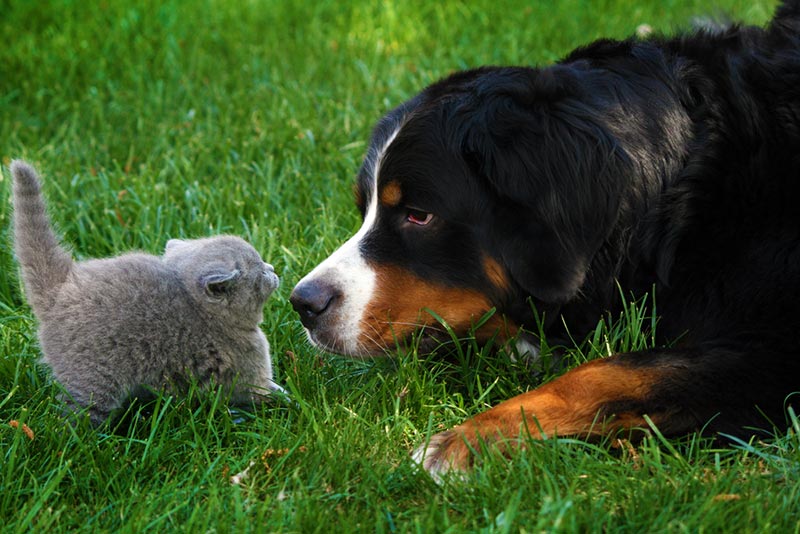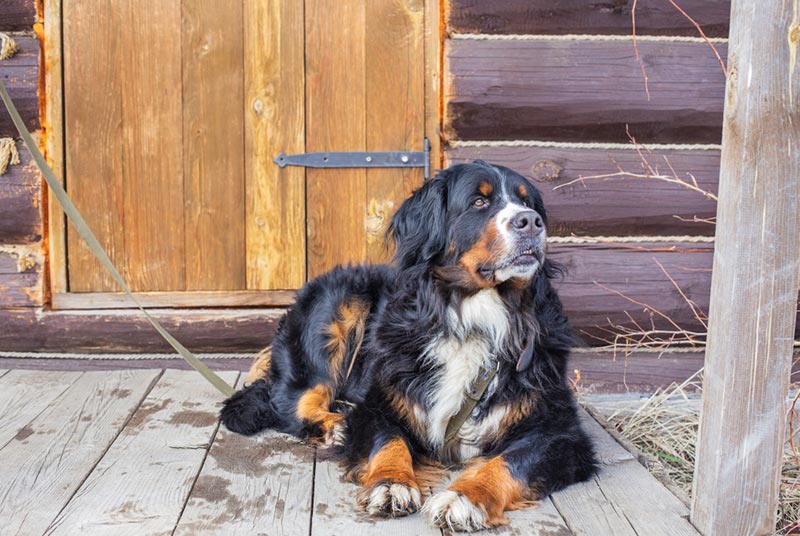Do Bernese Mountain Dogs Get Along with Cats? Compatibility Facts & FAQ
By Jessica Kim
Updated on

Bernese Mountain Dogs are popular pets for first-time dog owners and families with young children because of their loyalty and sweet nature. While Bernese Mountain Dogs are typically gentle and doting towards humans, it may take some time for them to get used to living with other pets. However, with proper socialization, it’s possible for this breed to live harmoniously with cats.
Bernese Mountain Dogs don’t tend to have a strong prey drive, so they’ll most likely get along with your cat. If anything, your cat may feel more intimidated due to their large size. So, make sure to introduce both pets to each other incrementally and supervise all initial interactions.
Bernese Mountain Dog Temperament
Bernese Mountain Dogs are known for being a well-rounded mix of confident and gentle. They have charming personalities and are intelligent and eager to please, making them relatively easy to train. They’re also known to be patient with children and don’t get riled up easily, as they’re relatively low-energy dogs.
You probably won’t see a Bernese Mountain Dog bothering a cat too much because they don’t really have a strong prey drive. So, most owners have an easier time training a Bernese Mountain Dog to live with cats than with many other breeds. These dogs are smart and fast learners that excel in obedience.

The 4 Steps to Introduce Bernese Mountain Dogs to Cats
Cats will most likely feel more wary of Bernese Mountain Dogs due to the size difference. So, it’s best to do slow introductions and gradually build up to increasing the amount of time they spend together. You can expect to manage and supervise pet interactions for several weeks or a couple of months.
1. Keep Pets Out of Each Other’s Views
Start with having both pets in separate areas, and make sure that your cat is able to easily access a dog-free zone. You can set up gates or have a designated room for your cat to ensure that your Bernese Mountain Dog won’t be able to get to your cat. To prevent overexcitement or anxiety, keep the pets in spaces where they can’t see each other. Even if they’re not in each other’s views, they’ll still be aware because of their scents and any sounds they might make.

2. Start Building Positive Associations for Each Pet
Next, work on building positive associations for each pet. You can have them eat near each other on opposite sides of a closed door and give them treats while they’re near each other. Do this until the pets are comfortable engaging in these activities.
3. Begin Face-to-Face Interactions with the Dog on a Leash
After that, you can start face-to-face interactions. Make sure to introduce your pets in a space that’s separate from their designated rooms so that they can return to a safe space where they know they won’t be intruded on by the other.
Keep your Bernese Mountain Dog on a leash and allow your cat to roam around the room. Have your dog sit and reward it for staying calm. You can also toss treats to your cat as well. If either pet shows signs of aggression, try to redirect them or calmly remove them from the room to avoid escalating the situation.
Continue with these interactions for the next several days or weeks until both pets feel and act calm in each other’s presence. Setting up these types of interactions multiple times a day can help speed up the process.

4. Release the Bernese Mountain Dog’s Leash
Once your pets are more comfortable with each other, you can let your Bernese Mountain Dog loose and allow it to walk around freely. Just keep the leash attached to its collar or harness in case it starts to make your cat feel uncomfortable and defensive.
You may have to supervise interactions for the next several weeks until you can completely trust your pets to co-exist without any issues. Always keep a dog-free space in your home for your cat to retreat to if it ever feels unsafe. Fortunately, you can use a lot of vertical spaces, like cat trees and shelves, that are unreachable for dogs but easily accessible for cats.
Final Thoughts
Bernese Mountain Dogs and cats can live together if they’re socialized properly. It’s best to go slower rather than faster to avoid any incidents that may cause distrust between each pet. So, be patient with the process and go at a pace that both pets are comfortable with, and you’ll eventually reach a place where your dog and cat can co-exist peacefully.
Featured Image Credit: Valery Shklovskiy, Shutterstock












